Predicting Multiparticulate Dissolution in Real Time for Modified- and Extended- Release Formulations
Process analytical technology, based on monitoring particle size distribution and tracking coating thickness measurements in real time, can be used to predict the dissolution of polymer-coated multiparticulates.
Dmitry Kalinovsk y/shutterstock.com

Process analytical technology, based on monitoring particle size distribution and tracking coating thickness measurements in real time, can be used to predict the dissolution of polymer-coated multiparticulates.Process analytical technology (PAT) describes the use of analytical instruments to measure specific product attributes during manufacturing, substantially minimizing the need to sample product for off-line analysis. This approach offers several key advantages including the ability to take process measurements in situ, with instant access to data, facilitating rapid decision making during product development and manufacturing.
Although the time between product sampling and obtaining off-line results may range from minutes to days, depending on the test being performed and the analytical structures in place, many PAT systems can measure results in real time. This capability enables process control decisions to be made, not just based on a recipe, but on the critical quality attributes (CQAs) of the material at that point in time. Access to data in real time can compensate for variabilities in raw material or mechanical wear in processing equipment components, and supports compliance with newer quality assurance (QA) initiatives such as continuous verification.
Many PAT instruments support the measurement of several physical and chemical quality attributes. One CQA that cannot be directly measured inline, however, is dissolution, due to the length of time required for testing. This is particularly true for modified- or extended-release formulations, for which dissolution testing can take several days or even weeks. If a method were available to generate dissolution data in real time by accurately predicting the dissolution test results of a modified-release product, development and production cycle times could be reduced significantly.
Figure 1: Particle size analyzer in place on the product container.
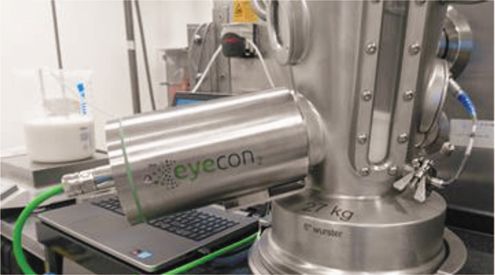
This article discusses tests that were conducted to show the feasibility of predicting dissolution drug release profiles on multiparticulates in a Wurster coating process. This approach required measuring coating thickness inline, based on growth in the material’s particle size distribution.
Table I. List of experiments. CPM is chlorpheniramine maleate and PRP is propranolol hydrochloride.
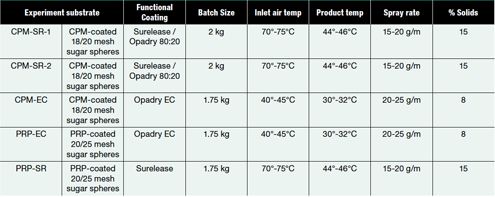
The goal of this work was not only to predict dissolution, but to explore the use of PAT for particle size distribution to measure coating thicknesses across a wide range of formulations (as shown in Table I).
Process settings were chosen based on the functional coating material. In each case, coating was added to achieve a predicted 20% weight gain. Samples were extracted from the process at time points corresponding to a predicted weight gain of 2.5%, 5%, 7.5%, 10%, 12.5%, 15%, 17.5%, and 20%, based on the quantity of coating solution sprayed.
Figure 2: Coating process profile, CPM-SR-1 (Chloropheniramine maleate-coated 18/20 mesh sugar spheres).
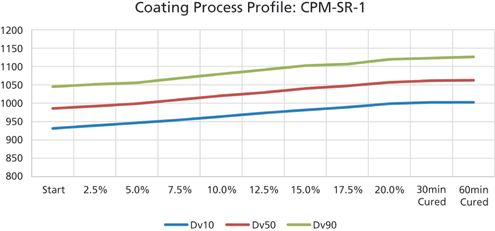
Additionally, for the aqueous-based functional coat (Surelease, Colorcon), samples were taken at 30 minutes and 1 hour of curing, and analyzed to determine dissolution. Separately, particle size distribution was measured.
Materials and equipment
Chlorpheniramine maleate (CPM) and propranolol hydrochloride (PRP) were layered onto sugar spheres (Suglets, Colorcon) with mesh sizes of 18/20 (850-1000 μm) and 20/25 (710-850 μm), respectively. CPM and PRP layered pellets (1.5-2 kg) were coated with aqueous ethylcellulose dispersion (Surelease, Colorcon) as a barrier membrane coating and Opadry hypromellose-based coating system (YS-1-19025-A, Colorcon) as a pore former, at 80:20 ratios.
Figure 3: Coating process profile (PRP-EC Ethyl-cellulose-coated propanolol hydrochloride layered pellets).
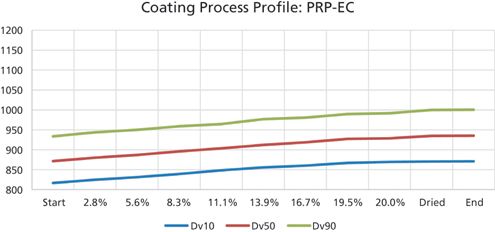
The coating dispersion was prepared by dissolving Opadry in deionized water and then added to coating to obtain total solid content of 15% w/w. A ethylcellulose (EC) organic coating system (Opadry EC, Colorcon) was used as an alternative fully formulated barrier membrane organic coating to evaluate the performance on CPM- and PRP-loaded pellets.
Figure 4: Particle size growth by sample point.
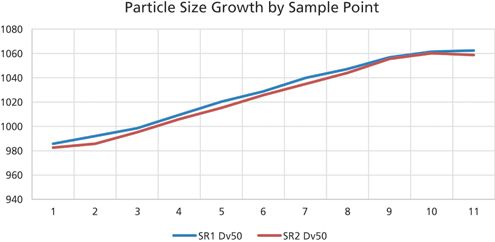
The coating solution was prepared in a 90:10 ratio of ethanol to water. The targeted coating weight gain was 18-20%, and samples were taken at every 2.5% of weight gain.
Coating system. A lab-scale fluid-bed dryer (GPCG-2, Glatt Air Technologies) with a six-inch Wurster product container was used for experiments. Critical process parameters are spray rate, atomizing air pressure, air volume, product temperature, orifice plate configuration, and partition height. Understanding and control of these parameters are crucial for a robust and reproducible process.
Figure 5: Particle size comparison, CPM-SR-1 (Chloropheniramine maleate-coated 18/20 mesh sugar spheres).
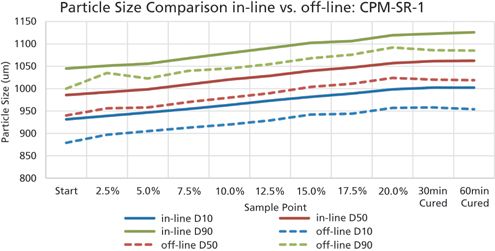
The product container used for these tests featured multiple suitably specified viewing windows to allow for installation of non-product-contact PAT, to avoid having the analytical equipment come into direct contact with product. The particle size analyzer (Eyecon2, Innopharma Technology) was installed on the lowest positioned window, as shown in Figure 1, for optimal measurement of pellets, in real time, during Wurster processing.
Figure 6: Correlation of in-line vs. off-line measurement data, CPM SR-1 (Chloropheniramine maleate-coated 18/20 mesh sugar spheres).
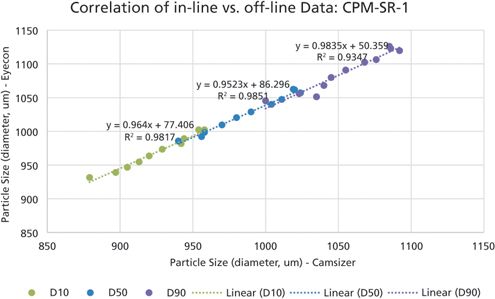
In general, the use of particle size, as well as moisture and API content measuring devices, can be utilized to gain full process understanding at an economic scale. Process understanding gained from designs of experiments (DOEs) at this scale can be translated into a robust commercial process with integrated real-time in-process product measurement and process control.
Figure 7: Particle size ranges, in-line vs. off-line.
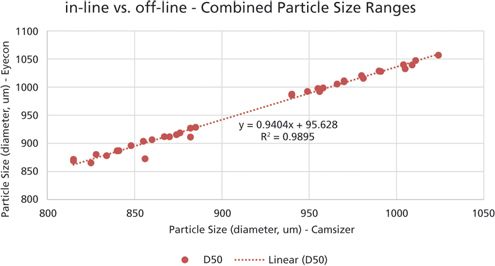
Analytical instrument. An non-product-contact direct-imaging particle analyzer (Eyecon, Innopharma Technology) was used to measure particle size change in real time, in-line, during processing, providing D Value and shape data as well as images of the particles. A typical lab type instrument using the principle of dynamic image analysis (Camsizer, Retsch Technology GmbH) was used to measure particle size distribution off-line, to assess the correlation of in-line and off-line measurements. Drug release was measured using a UV spectrometer from 1 gram of CPM and PRP barrier membrane-coated pellets in a dissolution bath using US Pharmacopeial Convention (USP) apparatus I (baskets) at 100 rpm. USP purified water was used as a dissolution media (1000 ml) at 37.0 ± 0.5 °C.
Results and discussion
Figures2 and 3 demonstrate the data from the in-line particle size analyzer, tracking two of the coating processes. While data are captured on a continuous basis, only data points corresponding to every 2.5% weight gain are shown here for clearer presentation and later comparison to off-line samples taken.
Figure 8: Film thickness as a factor of predicted weight gain.
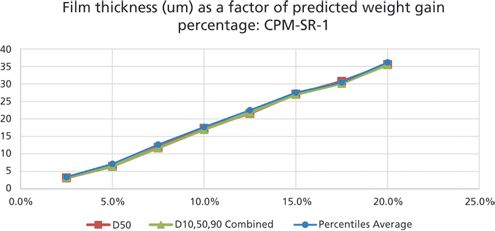
Dv50 is the volumetric median particle diameter, while Dv10 and Dv90 define the 10th and 90th percentiles. Together these three values provide a simple description of the particle size distribution.
A clear growth can be seen in each graph, though the overall size of the materials differs by approximately 100μm. This corresponds with the differing mesh sizes of the CPM and PRP pellets used. It is also evident that the final two data points in Figure 2 show negligible growth. These correspond to the curing process applied to the aqueous-based coating, during which no further material is sprayed, thus causing no weight gain at this point. Because the size does not appear to change either, it can be concluded that minimal density, abrasion, or film shrinkage effects are at play during the curing step. To allow for dissolution model building and establishment of the repeatability of the overall process and measurement techniques, two CPM experiments were run with identical process parameters. Figure 4 shows the Dv50s of each of these experimental runs. Minimal variance between the two processes can be seen. Because the offset between the two is relatively consistent across the duration of coating, the cause of the variance can most likely be attributed to minor variability in the starting material.
Figure 9: Film thickness as a factor of predicted weight gain percentage.
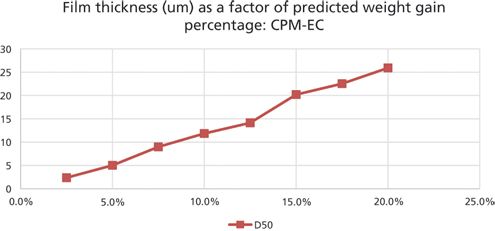
Next, the data measured with the in-line particle analyzer were compared to measurements using the off-line image analyzer.Because some variation is always present between different particle size measurement techniques (e.g., sieve, laser diffraction, back-light imaging), the primary goal was to establish a strong correlation between these two methods rather than to seek direct agreement.
Figure 5 shows measurements from the in-line particle size analyzer graphed against those from the off-line instrument. While a clear offset is present between the methods, a similar trend can be seen. Figure 6 plots the in-line and off-line results against each other for D10, D50, and D90 from the CPM-SR-1 experiment. It is evident from the fit lines that a high quality of correlation was present for all three values, with R2 for the Dv10 and Dv50 greater than 0.98. To ensure that this correlation holds across other experiments and material sizes, Figure 7 graphs the Dv 50s derived from inline measurements against those from off-line measurements for all sample points during the DoE.
Figure 10: Dissolution data grouped by time point.
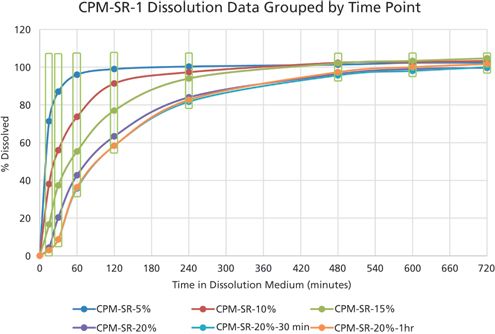
The two populations visible are due to the distinct size ranges of pellets used in the CPM and PRP experiments. A strong correlation is still present with an R2 for all points of almost 0.99. The D10 and D90 results correlate similarly.
Calculating film thickness from measured PSD
Although particle size and distribution can be measured using many off-line methods, dissolution performance is related more to the thickness of the functional coating, or the film thickness applied, than the overall size of the pellets. As such, the film thickness must be determined from measured size data. While the principle involved is simple (diameter increase during coating/2), there are different ways to define diameter increase. Figure 8 explores three methods: difference in the Dv50s, difference in the average of the Dv10, Dv50, and Dv90, and difference in the average of all the volumetric percentiles made from in-line measurements. In practical terms, the results of all three of these methods match closely, so Dv50 was chosen as the value used for further analyses. Figure 9 shows the calculated film thickness for the CPM coating experiment. Although a similar trend is evident, the total film thickness is considerably lower due to differing densities of the functional coating.
Predicting dissolution using in-line measurement
Because a number of factors affect dissolution beyond functional coating thickness, it was necessary to build a formulation-specific model for prediction based on the in-line-measured particle size. In the CPM-SR experimental runs, this was accomplished using data from CPM-SR-1 to build a correlated model against film thickness growth, which was then used to predict the dissolution results for the samples taken from CPM-SR-2. Although more data would result in a more robust prediction mechanism, this approach was considered sufficient to demonstrate a proof of concept.
Figure 11: Film thickness vs. dissolution.
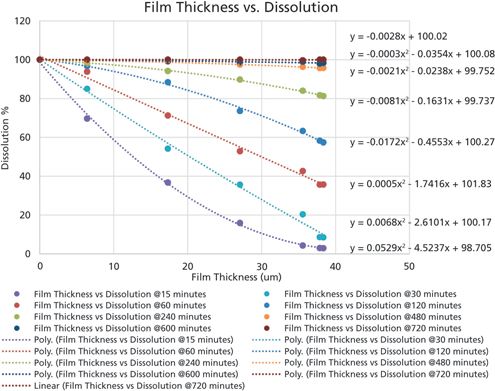
To build a prediction model from CPM-SR-1, the film thickness at each sampling point was first calculated as in Figure 9. Results were then graphed against the dissolution result, divided into data sets for each dissolution sampling time-point (as shown in Figure 10). Figure 10 shows the result of this process, applying best-fit polynomials to each of the data sets. The equations of the best-fit polynomials shown in Figure 11 effectively form the basis of predicting dissolution performance based on a measured film thickness. For a given thickness, an equation exists to describe the expected dissolution percentage for each time point measured in CPM-SR-1. To apply this to CPM-SR-2, the measured film thicknesses for each sample point were substituted into the polynomial equations from Figure 10, producing the data shown in Table II. Data from any point in the coating process could be used for this step, enabling dissolution to be predicted for any moment, but only sample points could be compared to off-line results, to validate the method.
Table II. Predicted dissolution results using In-line particle size measurements.

These data, when graphed, predict the dissolution curves. Figure 12 overlays the analytical measured dissolution data, denoted (A), over the predicted (P) dissolution performance.
Generally, the predicted dissolution curves overlap well with the measured results, showing the viability of the prediction method. Based on the limited size of the data set, better prediction could almost certainly be achieved by expanding the model data set from repetition of the experiment. For future experiments, the results of CPM-SR-2 can also be integrated into the predictive model to improve the accuracy and robustness of the prediction algorithms.
Figure 12: Predicted dissolution, with analytical results overlaid
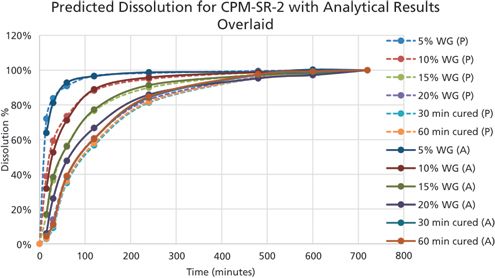
In short, these studies showed that a strong correlation exists between functional coating thickness and dissolution profile. In addition, research proved predicting the dissolution of a coating process in real time using particle size data and a formulation-based model is a viable control method. The work also illustrated the benefits of PAT in achieving greater process understanding and faster, more efficient process profiling. This approach could be used during process development, optimization, scale up and transfer, and showed the potential for using PAT particle size distribution trending as a process control or troubleshooting tool.
About the Authors
Piyush Patel, is formulation technologies manager at Colorcon, PA, ppatel@colorcon.com; Edward Godek is manager of process and technical operations at Glatt Air Techniques, NJ, info.gat@glatt.com; Chris O’Callaghan* is senior product manager at Innopharma Technology, Dublin, Ireland, ocallaghanc@innopharmalabs.com, and Ian Jones, PhD, is founder and CEO of Innopharma Technology and Innopharma College of Applied Sciences, Dublin.
*To whom all correspondence should be addressed
Article Details
Pharmaceutical Technology
Supplement: Solid Dosage Drug Development and Manufacturing
Vol. 41
April 2017
Pages: s20–s25
Citation
When referring to this article, please cite it as P. Patel et al., "Predicting Multiparticulate Dissolution in Real Time for Modified- and Extended- Release Formulations," Pharmaceutical Technology Solid Dosage Drug Development and Manufacturing Supplement (April 2017).
.

Pharmaceutical Tariffs Are Imminent: How Industry is Bracing for Impact
April 16th 2025On April 14, 2025, the Trump Administration launched a national security-driven investigation into pharmaceuticals, a move that will likely result in tariffs being placed on pharmaceutical drugs, ingredients, and other components that are imported from outside of the United States.
Drug Solutions Podcast: A Closer Look at mRNA in Oncology and Vaccines
April 30th 2024In this episode fo the Drug Solutions Podcast, etherna’s vice-president of Technology and Innovation, Stefaan De Koker, discusses the merits and challenges of using mRNA as the foundation for therapeutics in oncology as well as for vaccines.